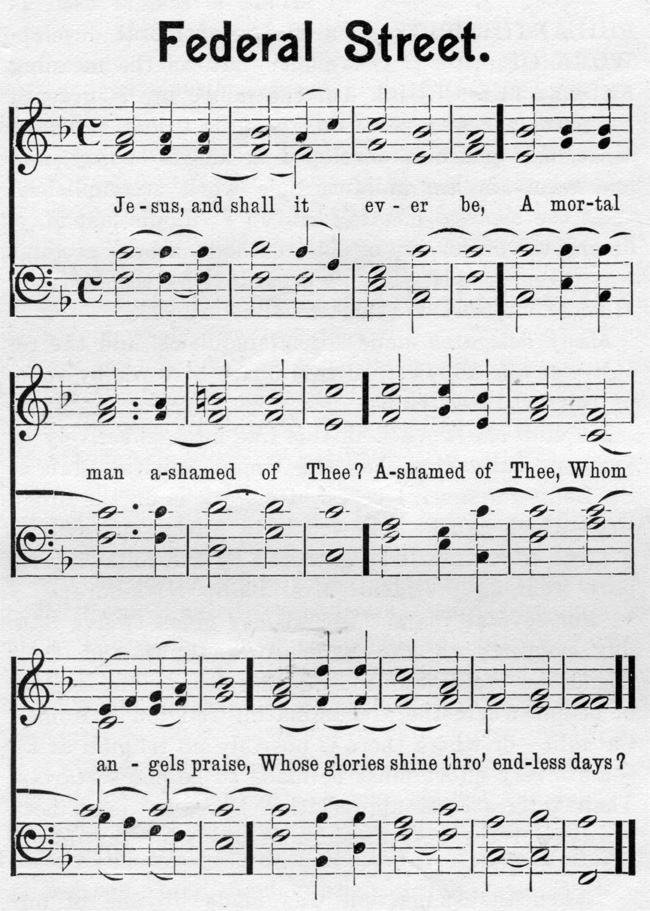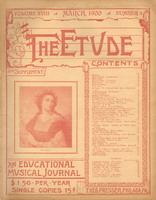Last month we considered the “announcement” of the tune—the selection of stops, etc., for playing the tune before the congregation sings it, and we now give our attention to
Accompanying the Congregation.
In accompanying congregational hymns three things are expected from the organ, viz.: the melody, the rhythm, and a proper support for the singing. If the organist will give special attention to these three points he will seldom have poor congregational singing.
Some congregations contain a large number of good singers, and good congregational singing is thus insured, even without the organ for assistance; but with the average congregation the organist can greatly strengthen the singing by a judicious method of accompaniment. In most cases the tune should be played as printed, in four parts, with the bass played by the pedal. It is better to play the bass part as printed, rather than to destroy the progression of that part by trying to play it all in the lower octave of the pedal key-board. The basses can follow their part easier, if it is played as they sing it, than if their part in the accompaniment progresses upward as they sing downward, and vice versâ.
Filling in the chords with the left hand may occasionally be effective, but it is generally detrimental to the good effect of the accompaniment. Without a good knowledge of harmony, this “doubling up” of the parts will cause many bad progressions and not a few dischords, beside destroying the clearness of the accompaniment. If the open diapason, the flutes, and string-toned stops together are not strong enough to support the congregation, it is better to add the octave (still playing in four parts), for, while this stop may be said to double the diapason, it does so evenly and will not destroy clearness. Adding the oboe, with the swell open, increases the “carrying power” of the accompaniment better than the “doubling up” process previously mentioned.
“What shall I do,” you ask, “when all the stops in my organ, except twelfth, fifteenth, and trumpet, fail to give sufficient support for the congregation?” I should prefer to add the twelfth and fifteenth rather than to produce a “muddy” effect by indiscriminately doubling the parts with the left hand. Let me repeat that a knowledge of harmony will enable the organist to double some of the parts in the left hand with good effect, but playing five notes with each hand for every chord of the tune is not agreeable to musical ears.
With regard to the melody of the tune, it has always seemed to me that it should be played as distinctly as possible; that every repeated note should be repeated distinctly, that the phrasing of the hymn should be observed, but, with these exceptions, that the melody should be played legato. I do not think it necessary to play the melody in octaves, except when the congregation is unusually large and the natural enthusiasm for some stirring hymn would call for it, but one must remember that two-thirds of the congregation are not sufficiently musical to sing a melody alone, and they naturally depend on what they hear from the organ.
Now, about the rhythm of the tune. If the organist ties all the notes of the tune in all four parts that he possibly can and plays soprano and bass strictly legato, the rhythm of most tunes could not be discovered. On the other hand, it is not necessary to adopt the custom of “piano-organists,” who detach every note of every chord, as they would on the piano, and play only an occasional pedal with the left foot while they maintain their equilibrium by keeping the right foot always on the swell pedal. If the melody is played distinctly and the pedal is played legato, except where there are repeated notes which should be repeated at least with the primary accents, the alto and tenor parts can be more or less tied and the rhythm will be distinct. Tying the inner parts will prevent “choppiness,” and playing the soprano and bass parts distinctly will emphasize the rhythm. The deep heavy notes of the pedal emphasize the rhythm as well as give a foundation to the harmony, but they should be played strictly legato except in the case of repeated notes. It is not necessary nor advisable to repeat the short notes of the bass part, but the accents, especially the first of every measure, should be repeated. To illustrate the foregoing look at the following tune:

It will be noticed that the melody is to be played just as printed, that very few of the bass notes are tied, but that the alto and tenor parts are tied enough to give a sustained effect to the whole. In the sixth measure (and similar places where the natural rhythm of the tune is broken) I have repeated the whole chord, as printed, which I find greatly assists the congregation.
The selection of stops for accompanying the congregation depends largely on the size of the organ. If the organ contains only five or six stops in the great it will be necessary to use all but the twelfth and fifteenth, and possibly to include those stops if the hymn is one of praise. If the organ is a large one, with twenty or more stops in the great, the organist will readily find various combinations, even without including the open diapason, which will support congregational singing. If the hymn is of a quiet character, one can use the flutes and string-toned stops of the great and swell, possibly with the oboe. Another good combination is the flutes of the great coupled to full swell with swell closed.
With small organs the organist will be limited to two or three combinations; but, with large organs, there are various combinations which can be used. Organs vary so much in their specification and voicing that it will be of little service to enumerate here the possible combinations of a large organ.
This short series of suggestions on hymn-playing will be concluded next month by a few suggestions relative to interludes.—Everett E. Truette.



